Western Digital SE16 750GB: "Quiet" a Performer
by Dave Robinet on August 9, 2007 2:00 AM EST- Posted in
- Storage
iPEAK Business Application Tests
Our iPEAK Winstone benchmarks offer a glimpse into how well our hard disk drives will handle general office applications, media encoding, and graphics manipulation. While the business applications that are being tested tend to be more CPU bound, the performance of the hard drive can and will make a difference in the more disk intensive video and graphics applications where large media files are typically being edited.
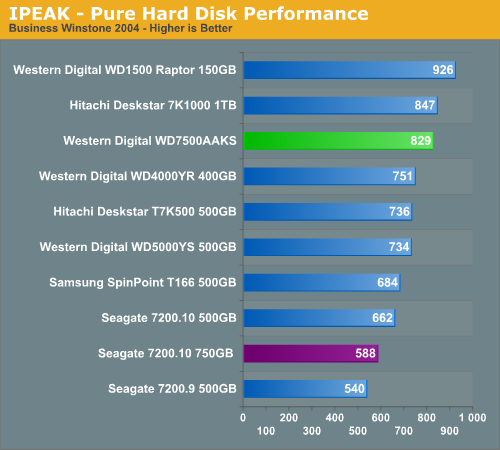
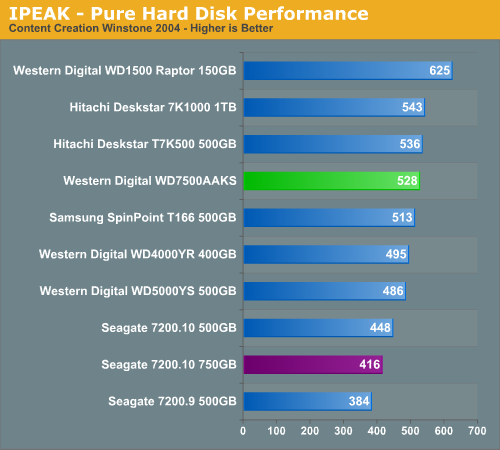
As expected, the Raptor drive continues its dominance in our benchmarks, but the WD7500AAKS turns in a very solid showing. Its Business Winstone score of 829 is slightly slower than the Hitachi 7K1000, but significantly faster than the Seagate 7200.10 750GB drive or any of the other 500GB drives we've tested.
iPEAK General Task Tests
The iPEAK based General Task benchmarks are designed to replicate utility based applications that typically are disk intensive and represent common programs utilized on the majority of personal computers. While the WinRAR program is very CPU intensive it will typically stress the storage system in short bursts. Our antivirus benchmark will stress the storage system with continual reads and sporadic write requests while the defragmentation process is split between continual read and write requests.
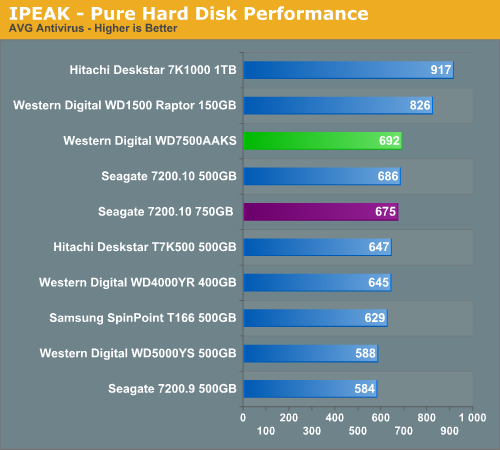
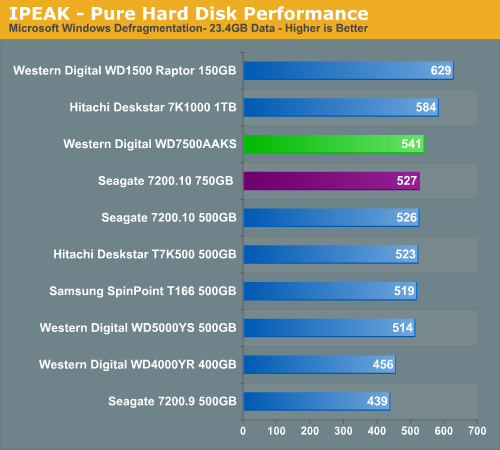
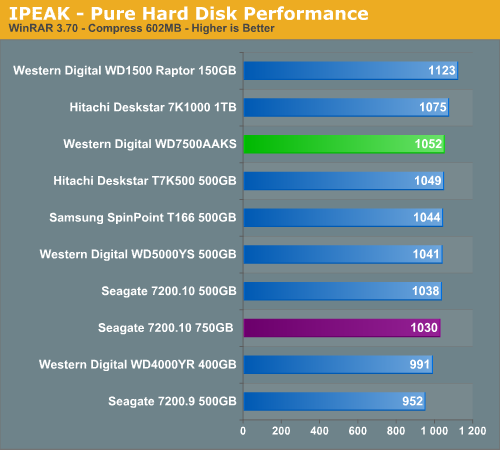
The WD 750GB performs consistently in third place in our benchmarks, producing results which are behind only the WD Raptor drive (hardly a fair comparison) and the other performance king, the Hitachi 7K1000. The only other 750GB drive tested (the Seagate 7200.10) is bested consistently by the WD7500AAKS.
Note that the WD7500AAKS does fall behind in the AVG Antivirus testing portion of this suite, coming in at a level close to the 7200.10 drive from Seagate. This is a significant improvement over previous WD SE series drives and indicates Western Digital has finely tuned their firmware for small block sizes of data in sequential order.
Our iPEAK Winstone benchmarks offer a glimpse into how well our hard disk drives will handle general office applications, media encoding, and graphics manipulation. While the business applications that are being tested tend to be more CPU bound, the performance of the hard drive can and will make a difference in the more disk intensive video and graphics applications where large media files are typically being edited.


As expected, the Raptor drive continues its dominance in our benchmarks, but the WD7500AAKS turns in a very solid showing. Its Business Winstone score of 829 is slightly slower than the Hitachi 7K1000, but significantly faster than the Seagate 7200.10 750GB drive or any of the other 500GB drives we've tested.
iPEAK General Task Tests
The iPEAK based General Task benchmarks are designed to replicate utility based applications that typically are disk intensive and represent common programs utilized on the majority of personal computers. While the WinRAR program is very CPU intensive it will typically stress the storage system in short bursts. Our antivirus benchmark will stress the storage system with continual reads and sporadic write requests while the defragmentation process is split between continual read and write requests.



The WD 750GB performs consistently in third place in our benchmarks, producing results which are behind only the WD Raptor drive (hardly a fair comparison) and the other performance king, the Hitachi 7K1000. The only other 750GB drive tested (the Seagate 7200.10) is bested consistently by the WD7500AAKS.
Note that the WD7500AAKS does fall behind in the AVG Antivirus testing portion of this suite, coming in at a level close to the 7200.10 drive from Seagate. This is a significant improvement over previous WD SE series drives and indicates Western Digital has finely tuned their firmware for small block sizes of data in sequential order.










37 Comments
View All Comments
Dave Robinet - Thursday, August 9, 2007 - link
Actually, the difference is that the EIDE drive only is offered up to a 500GB capacity. This precludes it from having the additional features given to the 750GB drive, as mentioned in the article.If you're only using the single drive under "normal" desktop usage, however, you're not terribly likely to see a big difference in performance between a 500GB SATA and 500GB EIDE, all things being equal.
Thanks for reading!
dave
semo - Thursday, August 9, 2007 - link
i understand the sata vs. pata arguments. it's just the new features and low power draw that interest me and since the model numbers look so similar i thought that they would share the same characteristics.Frumious1 - Thursday, August 9, 2007 - link
Besides the one using a slower, outdated interface? Probably not. Thankfully, the 750GB drive is NOT available in PATA format as far as I can tell. WD's EIDE offerings top out at 500GB on their website. Seriously, who buys a top-end hard drive in EIDE format these days? Hell I only have one IDE connection on my motherboard, and that's no longer in use!semo - Thursday, August 9, 2007 - link
the 750gb version may be a top end part but the 500gb is very reasonably priced. anyway, you can never convince me that a hard drive is "high end", whatever the cost. real world performance does not vary much and depends very much on usage patterns. now an ssd or a revolutionary redesign of hdd i can consider to be high end.Dave Robinet - Thursday, August 9, 2007 - link
Agreed - if you can use SATA, you will. Some people can't, however, and the EIDE interface isn't an incredible bottleneck to the system (like, for example, the move from ISA to PCI graphics cards was in adopting the new bus).You're right, though - there's no reason to intentionally buy EIDE anymore if you have SATA available in your system. :)
Thanks for reading!
dave
Basilisk - Thursday, August 9, 2007 - link
'Won't there be negligible P-ATA demand, with none from manuf's? So, 'probably no P-ATA version, or a hefty premium on it.If my Linux distro supported the S-ATA controller chip, I'd spend the $20-$25 on a PCI or PCI-e S-ATA card and ignore the P-ATA. It would be a shame to have that P-ATA 750GB and later find yourself w/o a m/b having P_ATA to make good use of it! [Okay, you could probably buy a P-ATA controller card....]
wilburpan - Thursday, August 9, 2007 - link
Who buys a large capacity EIDE hard drive? I did recently.Why? I have an old computer that I've repurposed into a file server running Linux. This computer is old enough that it doesn't have SATA connections.